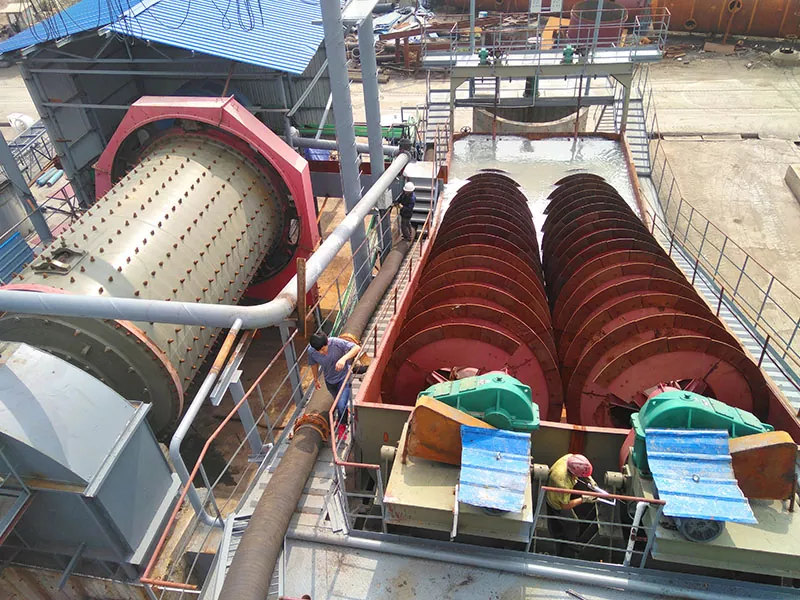 English
English Español
Español  Português
Português  русский
русский  Français
Français  日本語
日本語  Deutsch
Deutsch  tiếng Việt
tiếng Việt  Italiano
Italiano  Nederlands
Nederlands  ภาษาไทย
ภาษาไทย  Polski
Polski  한국어
한국어  Svenska
Svenska  magyar
magyar  Malay
Malay  বাংলা ভাষার
বাংলা ভাষার  Dansk
Dansk  Suomi
Suomi  हिन्दी
हिन्दी  Pilipino
Pilipino  Türkçe
Türkçe  Gaeilge
Gaeilge  العربية
العربية  Indonesia
Indonesia  Norsk
Norsk  تمل
تمل  český
český  ελληνικά
ελληνικά  український
український  Javanese
Javanese  فارسی
فارسی  தமிழ்
தமிழ்  తెలుగు
తెలుగు  नेपाली
नेपाली  Burmese
Burmese  български
български  ລາວ
ລາວ  Latine
Latine  Қазақша
Қазақша  Euskal
Euskal  Azərbaycan
Azərbaycan  Slovenský jazyk
Slovenský jazyk  Македонски
Македонски  Lietuvos
Lietuvos  Eesti Keel
Eesti Keel  Română
Română  Slovenski
Slovenski  मराठी
मराठी  Srpski језик
Srpski језик
What is a Spiral Classifier?
2025-08-27
In the world of mineral processing and mining, efficiency and precision are paramount. One of the most critical pieces of equipment used to achieve these goals is the spiral classifier. This article provides a comprehensive overview of what a spiral classifier is, how it functions, its applications, and the technical specifications that make it an indispensable tool in mining operations. We will delve into the key parameters of our high-performance spiral classifiers, presented through detailed lists and tables to help you understand their capabilities. Whether you are new to the industry or a seasoned professional, this guide will offer valuable insights into optimizing your mineral processing activities.
Understanding the Spiral Classifier
A spiral classifier is a type of mechanical classification equipment used primarily in mineral processing plants to separate fine particles from coarse ones. It works on the principle of sedimentation, where the solid particles in a slurry settle at different rates based on their size, density, and shape. The spiral classifier uses a rotating spiral to agitate the slurry and lift the coarse material for discharge, while the finer particles overflow through a weir. This process ensures that the desired product size is achieved, improving the efficiency of downstream processes like flotation or leaching.
Spiral classifiers are widely used in grinding circuits as a closed-cycle operation to control the size of the material being fed into the mill. They are also employed in pre-classification, desliming, and dewatering applications. Their robust design, low maintenance requirements, and high reliability make them a preferred choice in mining operations worldwide.
Types of Spiral Classifiers
Spiral classifiers can be categorized based on the method of discharging the settled coarse material. The two main types are:
-
High Weir Spiral Classifier:
The overflow weir is positioned higher than the center of the spiral shaft. This design allows for a larger settlement area, making it suitable for operations where a finer classification is required. It is commonly used in circuits where the overflow needs to be of a uniform size. -
Submerged Spiral Classifier:
The spiral is immersed below the overflow weir, providing a larger pool area and steeper inclination. This type is ideal for applications where the coarse material requires washing or dewatering. It is often used in environments where the overflow particle size is relatively coarse.
Both types are designed to handle a wide range of materials, including metallic ores, non-metallic minerals, and industrial sands.
Key Features of EPIC Mining Spiral Classifiers
At EPIC Mining, we engineer our spiral classifiers to meet the highest standards of performance and durability. Here are some of the standout features of our products:
-
Heavy-Duty Construction: Built with high-quality materials, our spiral classifiers are designed to withstand the harshest mining conditions.
-
Efficient Spiral Design: The spirals are fabricated from wear-resistant steel or polyurethane, ensuring long service life and reduced downtime.
-
Adjustable Weir Plates: Allows operators to control the classification precision by adjusting the height of the weir.
-
Low Power Consumption: Our classifiers are optimized for energy efficiency, reducing operational costs.
-
Easy Maintenance: Accessible components and simple design make maintenance straightforward and cost-effective.
-
Customizable Options: We offer tailored solutions to meet specific operational requirements, including size, capacity, and material compatibility.
Technical Parameters of EPIC Mining Spiral Classifiers
To help you better understand the capabilities of our spiral classifiers, we have compiled detailed technical specifications. The following tables outline the key parameters for our standard models.
Table 1: General Specifications
| Model Number | Spiral Diameter (mm) | Tank Length (mm) | Tank Width (mm) | Motor Power (kW) | Processing Capacity (t/h) |
|---|---|---|---|---|---|
| EPC-SC-750 | 750 | 8,500 | 1,500 | 5.5 | 15-30 |
| EPC-SC-1000 | 1,000 | 9,000 | 2,000 | 7.5 | 30-60 |
| EPC-SC-1500 | 1,500 | 10,000 | 2,500 | 11 | 60-120 |
| EPC-SC-2000 | 2,000 | 11,000 | 3,000 | 15 | 120-200 |
| EPC-SC-3000 | 3,000 | 12,500 | 3,500 | 22 | 200-350 |
Table 2: Performance Parameters
| Model Number | Max Feed Size (mm) | Overflow Particle Size (mm) | Spiral Speed (rpm) | Inclination Angle (degrees) | Water Consumption (m³/h) |
|---|---|---|---|---|---|
| EPC-SC-750 | 15 | 0.15-0.20 | 4-6 | 14-18 | 10-20 |
| EPC-SC-1000 | 20 | 0.15-0.20 | 3-5 | 14-18 | 20-40 |
| EPC-SC-1500 | 25 | 0.15-0.20 | 2-4 | 14-18 | 40-80 |
| EPC-SC-2000 | 30 | 0.15-0.20 | 2-4 | 14-18 | 80-120 |
| EPC-SC-3000 | 35 | 0.15-0.20 | 2-4 | 14-18 | 120-200 |
Applications of Spiral Classifiers
Spiral classifiers are versatile machines used in various stages of mineral processing. Some common applications include:
-
Closed-Cycle Grinding: Working in conjunction with ball mills to ensure that the feed to the mill is of the desired size.
-
Pre-Classification: Separating fine particles before they enter the grinding circuit to improve efficiency.
-
Desliming: Removing slimes from ores to enhance the performance of subsequent processes like flotation.
-
Dewatering: Reducing the moisture content in coarse materials for easier handling and transportation.
-
Sand Washing: Cleaning and classifying sand for construction and industrial uses.
Advantages of Using EPIC Mining Spiral Classifiers
Choosing the right spiral classifier can significantly impact your operation's productivity and cost-effectiveness. Here’s why our spiral classifiers stand out:
-
Superior Classification Efficiency:
Our designs ensure precise separation of particles, resulting in a high-quality overflow product. -
Durability and Reliability:
Constructed with abrasion-resistant materials, our classifiers offer extended service life with minimal maintenance. -
Energy Efficiency:
Optimized motor and spiral designs reduce power consumption without compromising performance. -
Customization:
We work closely with clients to develop classifiers that meet their specific needs, including unique sizes and materials. -
Global Support:
With a worldwide network of service centers, we provide timely support and spare parts to minimize downtime.
How to Select the Right Spiral Classifier
Selecting the appropriate spiral classifier for your operation depends on several factors:
-
Feed Material Characteristics: Consider the size, density, and abrasiveness of the ore.
-
Processing Capacity: Determine the required throughput to match your production goals.
-
Particle Size Requirements: Define the desired overflow and underflow particle sizes.
-
Site Conditions: Account for space limitations, power availability, and environmental factors.
Our technical team at EPIC Mining is always ready to assist you in choosing the perfect classifier for your needs.
Conclusion
Spiral classifiers are indispensable in modern mineral processing, offering efficient and reliable classification of materials. With their robust construction, low energy consumption, and versatility, they play a crucial role in enhancing the overall efficiency of mining operations. At EPIC Mining, we take pride in manufacturing high-quality spiral classifiers that meet the diverse needs of our global clientele.
I invite you to experience the EPIC Mining difference firsthand. Reach out to us at info@epicminingmach.com for more information or to discuss how our spiral classifiers can optimize your processes. Let’s build a more efficient and profitable future together.
c




